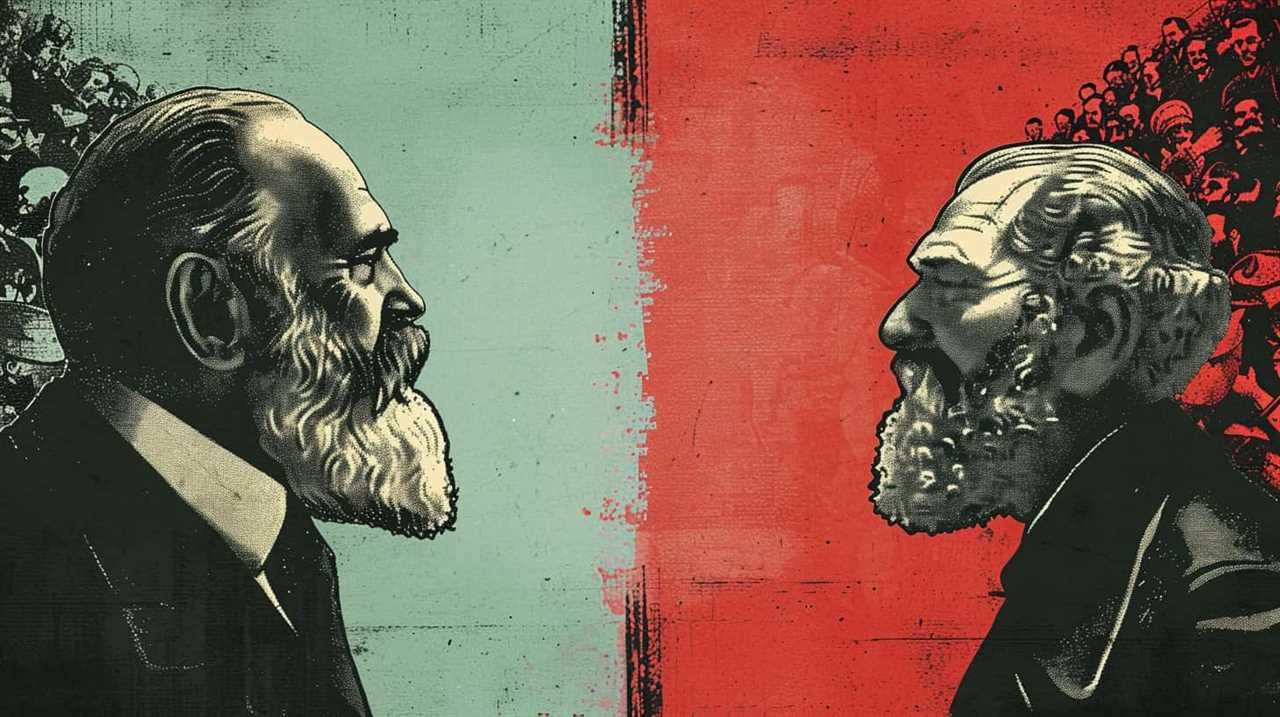Do you know that John Nash, the renowned game theorist, revolutionized our understanding of strategic decision-making?
In his groundbreaking work, Nash introduced profound insights that continue to shape our understanding of human behavior and strategic interactions.
In this article, we will explore six strategic insights derived from Nash’s work that will enhance our mastery of decision-making.
We will delve into the importance of rational decision-making, the role of self-interest in strategy, and the concept of Nash Equilibrium, which unveils optimal solutions in complex situations.

Additionally, we will explore the intriguing dynamics of game theory and strategic interactions, highlighting the unpredictability and uncertainty that often accompany decision-making.
Lastly, we will discuss the power of collaborative strategies in achieving successful outcomes.
Join us on this journey as we uncover the profound wisdom of John Nash and its implications for strategic decision-making.
Key Takeaways
- Rational decision-making is crucial for successful strategic planning and problem-solving, as it helps determine optimal strategies and predict game outcomes.
- Balancing self-interest and ethical considerations leads to strategies that benefit both individuals and the greater good, emphasizing the importance of considering ethical considerations when incorporating self-interest into strategy.
- Balancing cooperation and competition is crucial for success, as collaboration fosters teamwork and innovation, while competition fuels individual growth. Striking the right balance between the two leads to optimal outcomes.
- Strategic thinking and analytical approach are important in decision-making, involving anticipating actions, assessing all possible outcomes, and adapting strategies to changing dynamics. Additionally, considering other players’ decisions and analyzing game dynamics is crucial.
Importance of Rational Decision-Making
Rational decision-making is essential for successful strategic planning and effective problem-solving. When it comes to making decisions, emotions and cognitive biases can often cloud our judgment and hinder our ability to make rational choices.

Emotions play a significant role in decision-making, as they can influence our perceptions, attitudes, and behaviors. For example, fear can lead us to make hasty decisions without fully considering the consequences, while excitement can cause us to overlook potential risks.
Cognitive biases, on the other hand, are inherent flaws in our thinking processes that can lead to irrational decision-making. These biases can include overconfidence, confirmation bias, and anchoring bias, among others. Being aware of these biases and actively working to mitigate their effects is crucial for making rational decisions.
By understanding the role of emotions and cognitive biases in decision-making, we can strive to make more objective and informed choices, enhancing our strategic planning and problem-solving abilities.
Transitioning into the subsequent section about the role of self-interest in strategy, it’s important to recognize that while rational decision-making is vital, it isn’t the only factor at play.

The Role of Self-Interest in Strategy
In the realm of strategic planning, our self-interest plays a pivotal role in shaping our decision-making processes. When creating strategies, we’re often driven by the desire to maximize our own benefits and outcomes. This self-interest is fueled by the role of incentives, which serve as motivators for individuals to act in certain ways. Incentives can be both financial and non-financial, such as the potential for higher profits or the desire for recognition and status. They play a crucial role in influencing our strategic choices, as we tend to prioritize options that offer the greatest personal gain.
However, it’s important to consider ethical considerations when incorporating self-interest into strategy. While pursuing our own interests can lead to short-term gains, it may also lead to negative consequences for others or the overall organization. It’s crucial to strike a balance between self-interest and ethical considerations, ensuring that our strategies align with moral principles and values. By taking into account the potential impact of our actions on various stakeholders and societal norms, we can develop strategies that not only benefit ourselves but also contribute to the greater good.
Nash Equilibrium and Optimal Solutions
When considering Nash Equilibrium and optimal solutions in game theory, we must focus on rational decision-making. Players aim to maximize their own payoffs while also considering the actions of others.
This delicate balance between cooperation and competition leads to the search for optimal outcomes where no player has an incentive to unilaterally deviate from their strategy.

Rational Decision-Making in Games
We can achieve optimal solutions in games by making rational decisions, as demonstrated by the concept of Nash equilibrium. Rational decision making involves analyzing the potential outcomes of different choices and selecting the one that maximizes our expected payoff.
In the field of game theory, Nash equilibrium provides a framework for identifying the optimal strategy for each player in a game. Here are some key ideas related to rational decision-making in games:
- Rational decision making involves considering the preferences and objectives of the players.
- Nash equilibrium is a state in which no player can improve their payoff by unilaterally changing their strategy.
- In a two-player game, a Nash equilibrium is reached when both players choose their best response to the other player’s strategy.
- Nash equilibrium can be used to analyze various types of games, including cooperative and non-cooperative games.
- By identifying Nash equilibrium, we can determine the optimal strategies for each player and predict the likely outcomes of the game.
Balancing Cooperation and Competition
Balancing cooperation and competition requires finding the optimal solutions within the framework of Nash equilibrium.
In the workplace, there’s a constant tension between collaboration and competition. While collaboration fosters teamwork and innovation, competition fuels individual growth and achievement. However, striking the right balance between these two forces is crucial for achieving success.

It’s essential to recognize that individual goals and team objectives aren’t mutually exclusive. Instead, they can be aligned to create a win-win situation. This involves encouraging employees to pursue their individual goals while also contributing to the overall success of the team.
Finding Optimal Outcomes
To achieve optimal outcomes, it’s important to understand Nash equilibrium and strive for optimal solutions. In decision optimization, maximizing outcomes requires careful analysis and strategic thinking. Here are five key points to consider:
- Nash Equilibrium: This concept refers to a situation where no player can benefit by changing their strategy unilaterally. It represents a stable state in which each player’s decision is optimal given the decisions of others.
- Identifying Optimal Solutions: Finding optimal solutions involves analyzing the different strategies and payoffs for each player to determine the best course of action.
- Strategic Thinking: It’s essential to think strategically and anticipate the actions and reactions of other players to maximize outcomes.
- Analytical Approach: Decision optimization requires a systematic and analytical approach to assess all possible outcomes and determine the best strategy.
- Iterative Process: Achieving optimal outcomes often involves an iterative process of adjusting strategies based on the changing dynamics of the game.
Game Theory and Strategic Interactions
When it comes to game theory and strategic interactions, there are several key points to consider.
Firstly, it’s important to understand the optimal decision-making strategies that can be employed in different scenarios. This involves analyzing the potential outcomes and payoffs of each choice and selecting the one that maximizes individual or collective benefit.

Secondly, the behavior of players can vary between being competitive or cooperative, depending on the specific game and its incentives.
Lastly, information asymmetry plays a crucial role in strategic interactions, as it can impact the decisions and actions of players, leading to different outcomes.
Optimal Decision-Making Strategies
One of the key aspects of strategic interactions is understanding the importance of making optimal decisions. In the realm of game theory, optimal decision-making strategies are crucial for achieving favorable outcomes. However, human decision-making is often influenced by bounded rationality and decision-making biases, which can lead to suboptimal choices.
To overcome these challenges, it’s essential to employ effective strategies that maximize utility and minimize risks. Here are some key strategies to consider:

- Analyzing the game structure and identifying potential outcomes
- Assessing the goals and preferences of other players
- Anticipating and responding to the actions of others
- Considering the potential payoffs and risks associated with different choices
- Adapting strategies based on the evolving dynamics of the game
Competitive Versus Cooperative Behavior
We can approach strategic interactions from a competitive or cooperative standpoint, influencing the outcomes of game theory scenarios. When balancing individual interests, cooperative game theory offers a compelling solution. It emphasizes collaboration and mutual benefit rather than direct competition. By working together, players can achieve better outcomes and maximize overall gains. In contrast, a competitive approach focuses on individual success at the expense of others. This can lead to suboptimal results and potential conflicts. To illustrate the differences between competitive and cooperative behavior, consider the following table:
| Competitive Behavior | Cooperative Behavior |
|---|---|
| Self-centered | Collaborative |
| Zero-sum mindset | Win-win mindset |
| Maximizing own gains | Maximizing joint gains |
Role of Information Asymmetry
Information asymmetry plays a crucial role in shaping strategic interactions within game theory. Understanding its implications can provide strategic advantages in decision-making processes. Here are five key points to consider:
- Information asymmetry occurs when one party possesses more or superior information compared to others involved in the game.
- Asymmetric information can lead to strategic advantages for the informed party, allowing them to exploit the knowledge gap for better outcomes.
- The party with more information can strategically manipulate their actions to gain a favorable position, while the other party is left at a disadvantage.
- In game theory, understanding information asymmetry can help in predicting and analyzing strategic moves made by the players.
- Strategies such as signaling, screening, and strategic disclosure can be employed to mitigate the effects of information asymmetry and achieve better outcomes.
Unpredictability and Uncertainty in Decision-Making
Amidst the complexities of decision-making, navigating through unpredictability and uncertainty becomes a crucial factor for success. In the realm of decision making under uncertainty, the outcomes are often unpredictable, making it challenging for individuals to make informed choices. Uncertainty arises when there’s a lack of complete information about the potential outcomes or when the probabilities associated with these outcomes aren’t known. This lack of certainty creates a sense of unpredictability, making it difficult for decision-makers to accurately assess the risks and benefits associated with each option.
When faced with unpredictable outcomes, decision-makers must employ strategies that mitigate the inherent uncertainty. One approach is to gather as much information as possible to reduce uncertainty and increase the predictability of outcomes. This can involve conducting thorough research, seeking expert opinions, and analyzing historical data. Another strategy is to consider multiple scenarios and their associated probabilities, allowing decision-makers to assess the potential outcomes under different circumstances.

It is essential for decision-makers to acknowledge the presence of uncertainty and to develop a mindset that embraces it. Instead of being paralyzed by the unpredictability, they should view it as an opportunity for innovation and adaptation. By accepting uncertainty as a natural part of the decision-making process, individuals can approach decisions with flexibility and resilience, enabling them to navigate through the complexities and increase their chances of success.
What are the Key Strategic Insights That Game Theorist John Nash Is Known For?
John Nash game theory principles revolutionized the study of strategic decision-making. His concepts of equilibrium and cooperation have had a lasting impact on economics, politics, and business strategy. Nash’s insights into non-cooperative games and bargaining strategies remain fundamental to understanding competitive interactions.
The Power of Collaborative Strategies
To effectively navigate through unpredictability and uncertainty in decision-making, it’s crucial for us to harness the power of collaborative strategies. Collaborative partnerships and effective teamwork can yield significant benefits in complex and dynamic environments. Here are some key reasons why collaborative strategies are essential:
- Synergy: When individuals from diverse backgrounds come together, they bring unique perspectives and expertise. By leveraging these diverse strengths, collaborative partnerships can generate innovative and creative solutions that would be difficult to achieve individually.
- Shared Responsibility: Collaborative strategies promote a sense of shared responsibility among team members. This fosters a collective commitment to achieving common goals, leading to increased accountability and motivation.
- Enhanced Problem-Solving: Effective teamwork allows for the pooling of knowledge and experience, resulting in more comprehensive problem-solving. Different team members can contribute different insights and approaches, leading to more robust and well-rounded solutions.
- Increased Adaptability: Collaborative strategies enable teams to adapt quickly to changing circumstances. By sharing information and resources, teams can respond more effectively to unexpected challenges and seize new opportunities.
- Improved Decision-Making: By involving multiple perspectives, collaborative strategies promote more informed decision-making. This reduces the risk of biases and errors, leading to more accurate and effective decisions.
Harnessing the power of collaborative strategies is essential for navigating the complexities and uncertainties of decision-making. By fostering collaborative partnerships and effective teamwork, organizations can achieve better outcomes and thrive in dynamic environments.
Frequently Asked Questions
How Did John Nash Contribute to the Field of Game Theory?
John Nash’s contributions to game theory include the development of Nash equilibrium, a concept that explains optimal decision-making in non cooperative games. He also explored the dynamics of cooperative games, like the Prisoner’s Dilemma.

What Are Some Real-World Applications of Game Theory?
Game theory has numerous applications in the real world. Its importance lies in providing insights and strategies for decision-making in fields like economics, politics, and biology. These applications help us understand complex interactions and make informed choices.
Can Game Theory Be Applied to Non-Competitive Scenarios?
In collaborative decision making, game theory can be applied to non-competitive scenarios by analyzing cooperative game situations. By considering the strategic insights of John Nash, we can uncover strategies for achieving optimal outcomes in such situations.
How Does Game Theory Help in Understanding Human Behavior?
Game theory insights provide a valuable framework for understanding human behavior. By analyzing strategic decision-making and considering the psychological implications, we can gain a deeper understanding of how individuals and groups interact and make choices.
Are There Any Limitations or Criticisms of Game Theory?
There are several limitations and criticisms of game theory. One interesting statistic is that only 4% of Nobel Prizes in economics have been awarded for work in game theory. These criticisms highlight the need for alternative approaches and future directions in understanding strategic behavior.

Conclusion
In conclusion, John Nash’s insights on game theory provide valuable knowledge for strategic decision-making. By emphasizing the importance of rationality, self-interest, and collaborative strategies, Nash highlights the key elements necessary for achieving optimal solutions in strategic interactions.
Furthermore, his understanding of unpredictability and uncertainty reminds us of the need to consider these factors when making decisions. Nash’s theories offer a valuable framework for understanding and navigating complex strategic situations.
Overall, Nash’s theories offer a valuable framework for understanding and navigating complex strategic situations.
Lauren’s talent in writing is matched by her passion for storytelling. Her love for books and deep understanding of culture and entertainment add a distinct flavor to her work. As our media and press contact, Lauren skillfully bridges the gap between afterQuotes and the broader media landscape, bringing our message to a wider audience.










